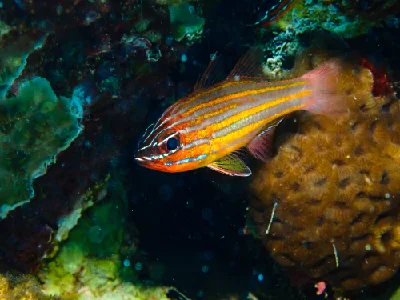Yellow-striped Cardinalfish
Ostorhinchus cyanosoma
The yellow-striped cardinalfish, scientifically known as Ostorhinchus cyanosoma, is a small marine species found in the Indo-West Pacific region. It typically grows to about 6 centimeters long, displaying blueish-silver coloration with orange-yellow stripes. Active mainly at night, it feeds on plankton and resides in coral reefs and lagoons at depths up to 50 meters.
First described by Pieter Bleeker in 1853, this species was later reclassified to the genus Ostorhinchus in 2014. It belongs to a species complex including Ostorhinchus rubrimacula, Ostorhinchus wassinki, and Ostorhinchus proundefinedptus, with Ostorhinchus proundefinedptus previously considered synonymous with Ostorhinchus cyanosoma.
Ostorhinchus cyanosoma inhabits the Indo-Pacific region, from the 🌊 Red Sea to areas like 🇦🇺 Australia and 🇳🇨 New Caledonia (🇫🇷 Overseas France). These fish prefer clear waters in reefs and lagoons, often seeking shelter under ledges or among sea urchins. They tend to form pairs within larger groups, displaying fidelity to specific sites for survival against predators.
Studies have shown parasite infections in Ostorhinchus cyanosoma, including those affecting the gall bladder caused by myxosporean parasites. Their diet primarily comprises benthic sergestid crustaceans but may vary based on availability.
As paternal mouthbrooders, male Ostorhinchus cyanosoma exhibit specific traits for protecting eggs. Pair bonding seems to be more about evading predators rather than genetic advantages, a characteristic found in various cardinalfish species.
During the day, these fish form visible groups on reefs, attracting divers and contributing to local economies. Moreover, they've been utilized in experiments demonstrating the potential negative impacts of increased ocean acidification due to elevated CO2 levels, showing similar effects to rising water temperatures caused by global warming. Fish in cooler regions appear more resilient to these changes compared to those in warmer areas.
Comments
Please, sign in to leave comment
No Comments yet
Last Update: May 28, 2025

